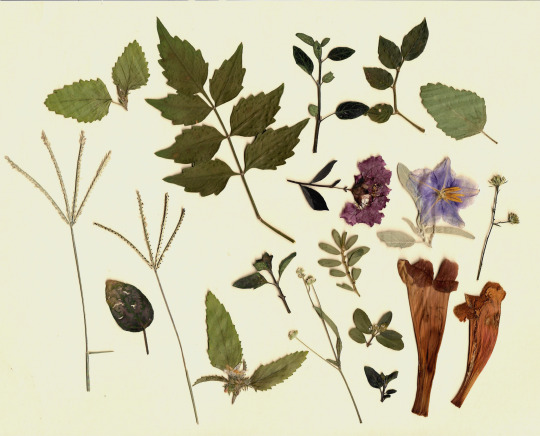#also bermuda grass is the devil's doing
Explore tagged Tumblr posts
Text






some garden bliss today
#i am. getting better at remembering sunblock#also bermuda grass is the devil's doing#i had one bed absolutely full of it and I was practically having to wrestle it out of the ground#my chickens are very sweet and followed me around the yard also#my onions and sweet peas and herbs are doing so good#had a surprise lettuce come up from last yr so i put it in its own lil area#so many neat lil bugs#anyway I'm still coated in sunscreen sweat and dirt bc wife requested it oop#samgaze
6 notes
·
View notes
Text
ooough I remembered about my little flower-pressing kit that I have and !! also the flowers I have pressed in the past!!!

(ID: A collection of dried, pressed plants against an off-white/beige background. It's mostly leaves and their stems versus flowers, though there are a couple large flowers in the lower right-hand corner. Notably, two orange trumpet-flowers, a pale purple silverleaf nightshade flower with prominent yellow pistils (? I hope that's right), and a pinkish-purple crepe myrtle flower. /end of ID)
I remember being able to get a lot of these because my dad moved out and none of us knew how to mow the lawn, so there were a bunch of "weeds" growing out back in addition to the few intentionally-planted... plants that were out there as well (tick city...)!! These are all a few years old at this point. Crazy to think about, actually.
But as much as I remember all of that, I don't remember what plants ALL of these came from. Especially the leaves. Though I was thinking about it and I feel like the largest leaves shown here were also from the trumpet-flower (also, I believe, called the "devil's shoelaces"... I believe that based on how prolific this plant was haha). I also remember some of the smaller leaves (perhaps you can't see it, but some of these leaves are "dappled") are from a "polka-dot plant" that I was taking care of for a while that died in a move. I miss that plant.
I believe the long, thin grasses (left-hand side) were "bermuda grass" that ended up flowering. I remember being to thoroughly fascinated when I realized that the little fuzzy-looking bits on the grass may've been FLOWERS, of all things. I didn't (and still don't) have a microscope or anything so I was unable to get a good look for myself, but I pressed them anyways. And the reason I'm confident about it being "bermuda grass" is because I remember my family putting down sod when we first moved to that house... Partly cuz I helped and it was so much work lmao.
One more thing that I might be remembering is that we had a lot of a plant that I struggled to identify growing in the backyard. AND I WOULD LIKE TO Clarify that I am not an expert!! This is very much JUST a hobby! Anyways, I think I settled on a plant (type of plant?) called "ragweed" due to knowing how quickly it spread and the way it looked/grew. It was a tall plant with, frankly, beautiful bunches of cute little white flowers. I never touched them a whole lot because I read somewhere that they can cause contact dermatitis... and I didn't really want to find out the hard way.
Anyways, I hope y'all think this as cool as I do. I also have some carnations that I pressed at my mom's request, so maybe I'll remember to scan those in too... We'll see.
Have a good day.
#marten's talkin#not art#pressed plants#forreals though i was so jazzed about finding these lmao#its crazy to think about how much time ive already dedicated to#learning abt my surroundings in such a short time#even though this feels like forever ago to me#anyways thanks for reading#i appreciate having a place to talk abt this stuff#my ex-friends used to look at me weird or interrupt me any time i tried to talk abt it w them... so yeah im grateful ig
0 notes
Text
How To Grow A Greener Lawn and Become the Envy of All
When you look at your neighbor's yard, perhaps you say to yourself, "The grass is always greener on the other side." Well, don't despair. Here are some tips for growing green lawns, including how touse lawn fertilizers, that will make it easy for you to get some respect for your own grass. Of course, assuming that it is only green grass that you wish to see carpeting your yard, informing you of methods for killing weeds is necessarily a part of any lawn-care advice. Most homeowners who want to have lusher, thicker lawns will not tolerate a dandelion weed or patch ofcrabgrass, regardless of how green it is. Fortunately, applying lawn fertilizers and practicing weed control can be combined into one job if you play your cards right. So why do some yards have beautiful green lawns, while, in others, the greenery always seems to lose ground over time to brown spots? All else being the same, the secret of having a green lawn lies in providing enough nutrients, practicing sound weed control, and following the proper mowing routine. But the devil is in the details, which we will get to. Let's begin, though, with that little clause, "all else being the same." For it's important to start out with an even playing field. First of all, let's shoot down the ideathat grass is simply grass, and that's all there is to it. In fact, there's a lot more to it than that. People grow many different types of grasses in their lawns, and these grasses have different growing needs. Many factors go into the selection of a type of grass for a particular lawn. One of the biggest factors is your local climate. The so-called "warm-season" grasses are ideal for the southern states in the U.S., whereas "cool-season" grasses do better in the North and in Canada.

In between, for the eastern U.S., lies the so-called "transition zone," made up of zones 6-7. This is a problematic area for growing grass: too hot for some grasses, too cold for others. Common cool-season grasses include: Bent grassBluegrassFescuesRye grass Among the common warm-season grasses are: Bermuda grassBuffalo grassZoysia grassCentipede grassBahia grassSt. Augustine grass Note, too, that lawns are not always made up of just one type of grass. Sometimes, they are made up of a mixture, to take advantage of the strengths of each type. The following are examples of other factors that go into your selection of grass type, in addition to local climate (these examples pertain to lawns in the northern zone and in the transition zone): Shady areas are a challengeto having green lawns. Among cool-season grasses, fine fescues are the most tolerant of shade.Lawn areas with heavy foot traffic need a tough grass. A mix of Kentucky bluegrass and perennial rye will fill the bill here.Some regions are more prone to drought than others. The new, improved strains of tall fescue are not only drought-tolerant, but they also blend in with Kentucky bluegrass better than do older strains. But, in addition to grass-type selection, there are other factors to consider to ensure that you start with a level playing field as you strive to unseat your neighbor for bragging rights to having the greenest lawn around. Lawn-Thatch Removal, Watering Lawns So you're serious about getting a lawn that's thicker and greener? Well, in addition to selecting the right type of grass for your yard, you have to deal with two more basic issues: thatch removal and watering your lawn. Let's consider watering first. What's the yearly rainfall to be expected in your region? In dry climates,installing an irrigationsystem is necessaryfor growing grass successfully. But, in the misty Pacific Northwest, it is understandable that many choose to let Mother Nature do the watering. For most of the rest of us, the decision of whether or not to have an irrigation system for watering lawns will not be so clear-cut. Cost will be a factor, but keep in mind that, in the long run, an irrigation systemmaysaveyou money, because it is more efficient than other ways of watering. One way or the other, your grass must have enough water on a consistent schedule in order for you to achieve the goal of a lush, green lawn. If your neighbors arewatering lawns with an irrigation system, and if you aren't, then you're not starting out with an even playing field. Finally, check that your grass does not suffer from alawn-thatchproblem: If yourthatch layer is 1/2 inch or less, you may proceed to the tips that follow.However, you won't get much good fromthe tips that follow unless you first deal with a thatch build-up that is much worse than 1/2 inch thick. If you fail to remove it, again, you're not starting out with a level playing field. Why? The two major reasons for thatch removal are that the thatch layer: Will prevent water from getting to the roots of your grass.Will give cover to unwanted insect pests. If your thatch build-up is right around 1/2 inch, you have a minor lawn thatch problem that is fairly easily dealt with. A thick layer (say, 3/4 inch or more) calls for the use of acore aeratoror a vertical mower. Both can be rented from your local rental center.
youtube
One of the best investments you could make to that end would be in a mulching mower. Using mulching mowers can not only cut down on your yard maintenance, but also makes your grass greener. Otherwise, you may end up either raking or bagging your grass clippings, which, in turn, means having to dispose of them or recycle them later. This is all extra work. Besides, hauling away your grass clippings means depriving your lawn of a natural fertilizer that can make your grass greener.

So how long should you waitbefore cutting the lawn? And how short should you cut your grass? According to the Cornell University Cooperative Extension, cutting the lawn with a mower setat a proper mowing heightcan save you from having to bag yourgrass clippings, even if you don't own amulching mower. The rule of thumb suggested by the Cornell Extension is, "Mow when your grass is dry and 3 to 3-1/2 inches tall. Never cut it shorter than 2 to 2-1/2 inches or remove more than one third of the leaf surface at any one mowing." The pointbehind this mowing tip is that the valuable nutrients in the grass clippings can do your lawn some good, left right where they lie after cutting, as long as their bulk is kept at a minimum. By following this rule of thumb and cutting only about an inch off the top of yourlawn at any one time,thebulk of the grass clippingsis kept low. Following this mowing tip means more frequent cutting, to be sure. But the result will be ahealthier lawn, fed by nutrients that you would otherwise be hauling away. Besides, cutting a lawn too short can stress it out, especially during periods of hot weather. In addition, cutting the lawn stimulates growth and increases thickness. You are, in effect, "pinching" your grass plants each time you mow, just as you pinchmany houseplantsor garden flowers to make them sturdier plants. Note that with mulching mowers, you don't need to be quite so careful about the height at which you cut the lawn,since the grass clippingsare shredded up more finely. This works much better for those of us who don't generally walk around with tape measures on our belts. Mowing Tips on "The Cutting Edge": When and How to Mow"The cutting edge": Be sure to keep mower blades sharp. Sharp mower blades produce clean cuts, and clean cuts promote better grass health. Dull mower blades, by contrast, produce rougher cuts that leave your https://www.mowersdirect.com/ grass wide open to diseases.When to mow: It puts less stress on the lawn to mow in the evening than to mow when the sun is pounding down in the afternoon.How to mow: Alternate the direction in which you mow each mowing session. If your mower wheels pass over the same area in the same direction each time you mow, they'll form ruts over time. https://www.thespruce.com/tips-for-growing-green-lawns-2130969
0 notes